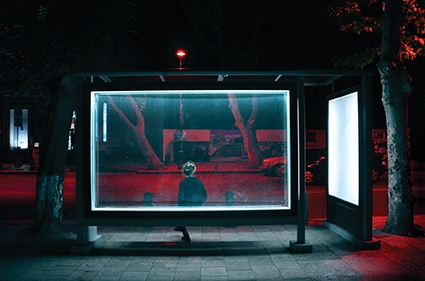Discover a Parallel World from a Georgian Photographer’s Perspective
Exclusive Interview
Time will pass and after decades we might recall today’s Tbilisi like we evoke Soviet Tbilisi in our memory when looking at old photos of the 70s. Photography is one of the most important archives recording the history of the city and different stages of its development. At present, we are witnessing Tbilisi in the process of transition from Post-Soviet to a modern European city. Georgian artist Sandro Bibliotekari, who captures night Tbilisi, shows the city from a totally different angle, unfolding the story the city conveys through his images. When I first came across Bibliotekari’s photos on the internet, I thought I was looking at the paintings of Edward Hopper brought to life. The more I went through his gallery, the more concealed details I discovered in the city; details that are sometimes invisible to us, or that we simply don’t pay attention to because it is a familiar environment. If you want to discover the parallel world of a Tbilisi that wakes up after dark, then definitely check out the sandro_bibliotekarii Instagram page. The alternative face of the capital of Georgia illuminated with neon lights, on the verge of old and new, will leave you impressed. It is also noteworthy that the photographer’s images have been spotlighted by international media and were featured in The Calvert Journal, the London-based online guide to the contemporary culture of the New East. GEORGIA TODAY spoke to Sandro to find out more.
When did you get into photography and how?
I always had an interest in visual arts. In particular, I was captivated by the modernism and postmodernism directions. Even though I graduated from the Tbilisi Academy of Arts, I never wanted to draw. I discovered my lust for photography when exploring other mediums. As it turned out, photography was relatively closer to me than painting. Exactly photography enabled me to express my views on the environment.
Your images are characterized by neon illuminations. How authentic are your photos?
I think it’s ok for an artist to use any way or tool available to achieve the aimed result and to express ones’ views, as well as transmit one’s message. I think he/she must use all the tools at hand. In Georgia there is a certain cliché that a photographer should depict the environment as it is without any interference. I totally disagree with this notion, since a viewer might not experience the same feelings and impulses that I felt when looking at a particular still. Everyone perceives the environment in their own way, so what is visible to me might be hidden to someone else, and vice versa. Subsequently, using artificial techniques and enhancing the image to convey a certain message is perfectly acceptable. This is my main goal: to show a particular moment from my perspective, the way I see it.
Your photos mainly depict “night” Tbilisi, with its bus stops, old buildings and streets. How would you describe your works?
My works were basically influenced by cinema, especially Film Noir of the 1940-50s and sci-fi of the 1980s. The synthesis of these two genres fueled my vision as a photographer. Apart from that, 80s music also had a great influence on me, namely Post Punk, New Wave and Synth Pop. In art, I would also single out American artist Edward Hopper and his artwork Nighthawks that affected my style as well. I draw my inspiration from the latter; trying to transfer this world into Tbilisi reality and depict it in my images.
How do you see Tbilisi as a citizen and an artist? What does the city lack?
This question reminds me of American comedian George Carlin’s monologue “Saving the Planet.” The city is a living organism that has its own mindset, memory and character. It is the way it should be; it does not lack anything and lives on its own and will live even longer, with us or without us. We are drawn by our selfish desires. Some people want to construct highways, some arrange greenery and more parks, some want parking lots with many floors, some the bypass road near Tbilisi Sea, some want to construct more apartment buildings while others want to destroy them. The city itself already represents a brutal intervention into nature, and our intention to modify it and make it a more comfortable place to live is a demonstration of egoism. In China, there was a city called Kowloon that was completely demolished in the 1990s. In fact, the city represented one big building, since it was an extremely densely populated settlement. The buildings clung to one another, almost totally blocking natural light. The inhabitants had to have their lights and streetlamps on day and night. The city lived on its own and none of the laws worked within its walls, just as in the films The City of Lost Children and Dark City. For me, such a city is more appealing and interesting to capture with a camera rather than India’s 12th century charming palaces filled with tourists, or even Berlin’s vast green parks.
Could you name a few favorite places in Tbilisi that are not widely known to the public?
I don’t known whether it is less known or not, but I like Barnovi Bridge over Kekelidze Street. If you look down at Kekelidze ascent from the bridge during night hours, it will remind you of a scene from the anime Ghost in the Shell or from Blade Runner. And the Tsereteli Avenue exhibition pavilions. The latter represents quite an interesting synthesis of Soviet postmodern brutal architecture and a green environment.
Lika Chigladze











